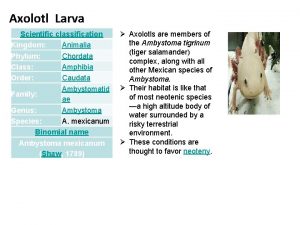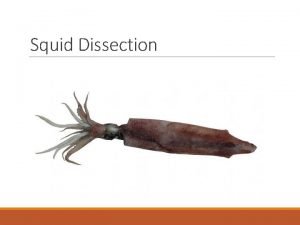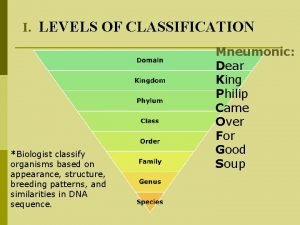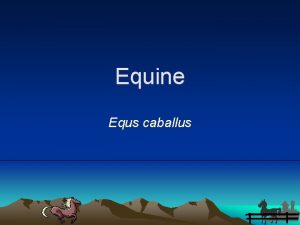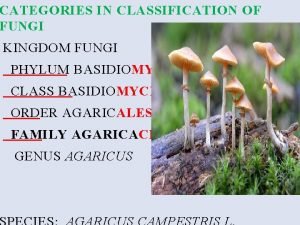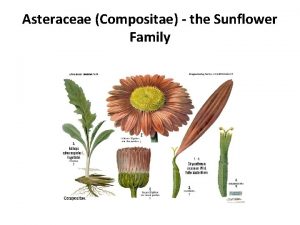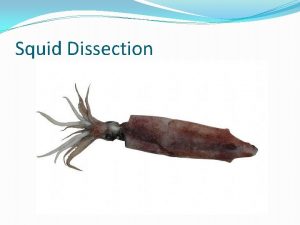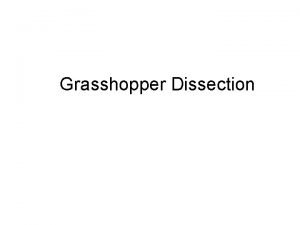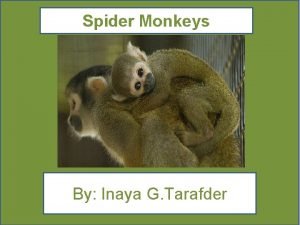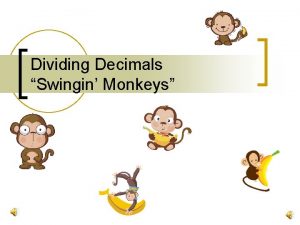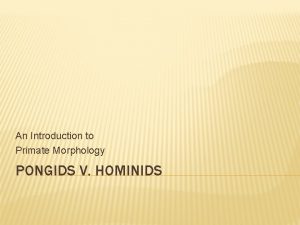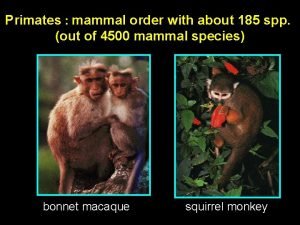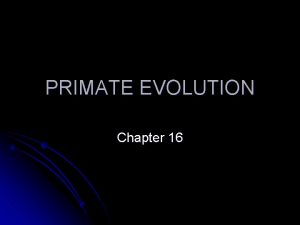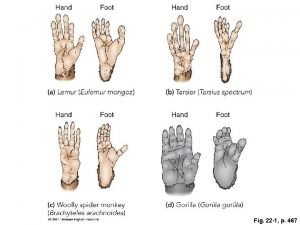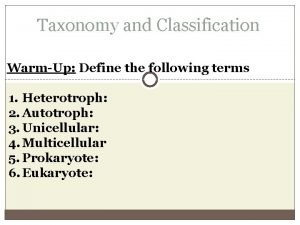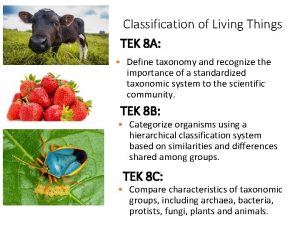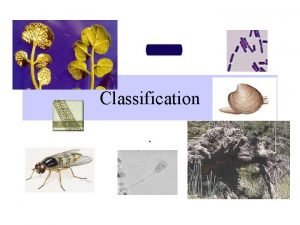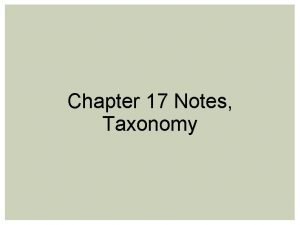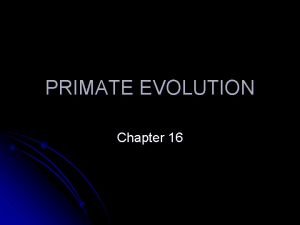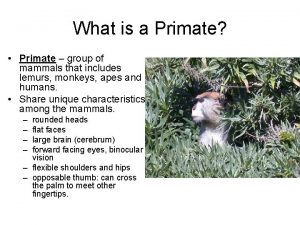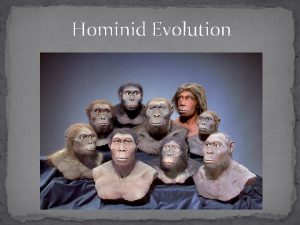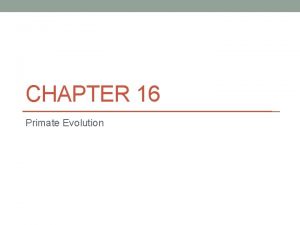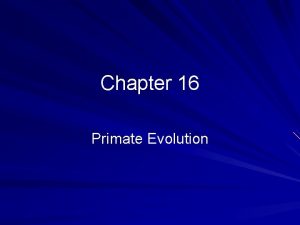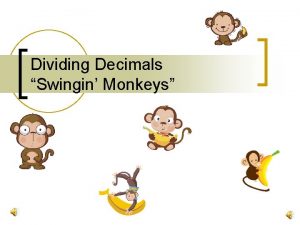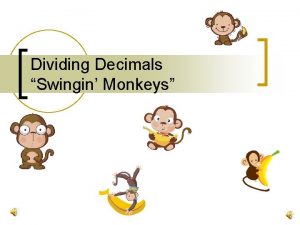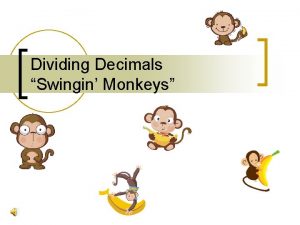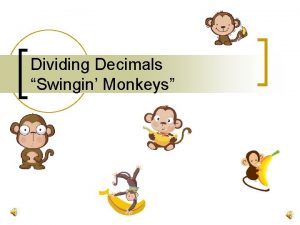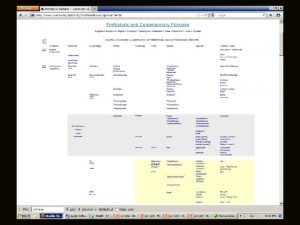Tim Roufs section Monkeys Primate taxonomic classification Understanding























































- Slides: 55

Tim Roufs’ section

Monkeys Primate taxonomic classification Understanding Physical Anthropology and Archaeology, 9 th ed. , p. 123

Anthropoids Primate taxonomic classification Understanding Physical Anthropology and Archaeology, 9 th ed. , p. 123

New World Monkeys Primate taxonomic classification Understanding Physical Anthropology and Archaeology, 9 th ed. , p. 123

Old World Monkeys Primate taxonomic classification Understanding Physical Anthropology and Archaeology, 9 th ed. , p. 123

Apes and Humans Primate taxonomic classification Understanding Physical Anthropology and Archaeology, 9 th ed. , p. 123

Primates -- Monkeys A. PROSIMII B. ANTHROPOIDS 1. Platyrrhines (“flat-nosed”) a. Ceboidea (New World monkeys) 2. Catarrhines (“down-nosed”) a. Cercopithecoids (Old World monkeys) b. Hominoidea (apes and humans)

New and Old World Monkeys

New World Monkeys Old World Monkeys ca. 50 mya

ca. 50 mya A Primate Family Tree The Emergence of Humankind, 4 th ed. , p. 64

New / Old World Monkeys New World Monkeys • found only in South and Central America Old World Monkeys

New World Monkeys Understanding Physical Anthropology and Archaeology, 9 th ed. , p. 128

New / Old World Monkeys New World Monkeys Old World Monkeys • found only in South and Central America • Found in the tropical and temperate climates of “The Old World” and the Far East

Old World Monkeys Understanding Physical Anthropology and Archaeology, 9 th ed. , p. 129

Primates are tropical and temperate climate creatures Distribution of Nonhuman Primates Humankind Emerging, 7 th ed. , p. 93

Vegetation Regions and Nonhuman Primates Humankind Emerging, 7 th ed. , p. 94

New / Old World Monkeys New World Monkeys • smallest and most divergent group of all anthropoids Old World Monkeys

New / Old World Monkeys New World Monkeys Old World Monkeys • some have lost prehensile tail • tails are shorter and never prehensile

p. 128 New World Monkey: Spider monkey (note prehensile tail) Understanding Physical Anthropology and Archaeology, 9 th ed. , p. 129

New / Old World Monkeys New World Monkeys Old World Monkeys • flat faces with nostrils separated with wide septum and directed more to the side • nostrils are much closer together and are directed forward and down

p. 128 p. 129

New / Old World Monkeys New World Monkeys Old World Monkeys • arboreal • except for baboon and mandrills the old world monkeys are usually arboreal

p. 128 Skeleton of an arboreal New World monkey (New World Monkey: Bearded saki) Understanding Physical Anthropology and Archaeology, 9 th ed. , p. 121

p. 129 Skeleton of a terrestrial quadruped (Old World Monkey: Savanna baboon) Understanding Physical Anthropology and Archaeology, 9 th ed. , p. 121

New / Old World Monkeys New World Monkeys Old World Monkeys • very reduced thumb • in some, the thumb is reduced • but in others it is not

p. 129 Old World Monkey: Macaque

New / Old World Monkeys New World Monkeys Old World Monkeys • usually have thick fur • hair cover is light

New / Old World Monkeys New World Monkeys • lead away from main line of evolution Old World Monkeys

New World Monkeys

p. 128 New World Monkey: Black Howler Monkey The Primates, Time-Life (1974) p. 47

p. 128 New World Monkey: Red Howler Monkey The Primates, Time-Life (1974) p. 47

p. 128 New World Monkeys: A pair of golden lion tamarinds Understanding Physical Anthropology and Archaeology, 9 th ed. , p. 128

p. 128 New World Monkeys: Howler monkeys Understanding Physical Anthropology and Archaeology, 9 th ed. , p. 128

p. 128 New World Monkey: Woolly Monkey The Primates, Time-Life (1974) p. 47

p. 128 New World Monkey: Squirrel Monkey The Primates, Time-Life (1974) p. 49

Old World Monkeys

p. 129 Old World Monkeys: Macaques Understanding Physical Anthropology and Archaeology, 8 th ed. , p. 127

p. 129 p. Old World Monkeys: Macaques

p. 129 Old World Monkeys: Macaques

p. 129 Old World Monkeys: Macaques

abcnews. go. com/Technology/wire. Story? id=5035837

p. 129 Old World Monkeys: Longtail macaques Understanding Physical Anthropology and Archaeology, 9 th ed. , p. 151

p. 129 Old World Monkeys: Baboons

p. 129 Old World Monkey: Savanna baboon (male) Understanding Physical Anthropology and Archaeology, 9 th ed. , p. 130

p. 129 Old World Monkey: Savanna baboon (female) Understanding Physical Anthropology and Archaeology, 9 th ed. , p. 130

p. 129 Old World Monkeys: Baboon troop De. Vore (ed. ), Primate Behavior, 1965) p. 70

p. 129 Old World Monkey: Baboon The Primates, Time-Life (1974) p. 119

p. 129 Old World Monkey: Baboon The Primates, Time-Life (1974) p. 117

p. 129 Old World Monkeys: Group of savanna baboons Understanding Physical Anthropology and Archaeology, 9 th ed. , p. 156

p. 129 Old World Monkey: Adolescent savanna baboons Understanding Physical Anthropology and Archaeology, 9 th ed. , p. 149

p. 129 Old World Monkey: Black and White Colobus The Primates, Time-Life (1974) p. 54

p. 129 Old World Monkey: Golden Langur The Primates, Time-Life (1974) p. 54

p. 129 Old World Monkeys: Langurs The Primates, Time-Life (1974) p. 100

p. 129 Old World Monkeys: Hanuman langurs Understanding Physical Anthropology and Archaeology, 9 th ed. , p. 153

Next: Apes Primate taxonomic classification Understanding Physical Anthropology and Archaeology, 9 th ed. , p. 123
 Thomas quarry
Thomas quarry Tim roufs
Tim roufs Purgatorius
Purgatorius Classification scheme of fungus and bacterium
Classification scheme of fungus and bacterium This is the study of grouping and naming organisms
This is the study of grouping and naming organisms Taxonomic classification of tiger
Taxonomic classification of tiger Axolotl facts
Axolotl facts Internal squid diagram
Internal squid diagram Levels of classification in order
Levels of classification in order Systematic position of horse
Systematic position of horse Taxonomic classification of crude drugs
Taxonomic classification of crude drugs Scientific classification order
Scientific classification order Phylum horse
Phylum horse Fungi phylum characteristics
Fungi phylum characteristics Sunflower taxonomic classification
Sunflower taxonomic classification Species family genus
Species family genus Phyla of squid
Phyla of squid How to dissect a grasshopper
How to dissect a grasshopper Taxonomic classification of fruit fly
Taxonomic classification of fruit fly Monkeys live in trees
Monkeys live in trees Spider monkey life cycle
Spider monkey life cycle Swinging monkeys
Swinging monkeys Who wrote the monkeys paw
Who wrote the monkeys paw Monkeys paw quiz
Monkeys paw quiz Monkeys eat peeled bananas chemistry
Monkeys eat peeled bananas chemistry The monkey s paw characters
The monkey s paw characters Monkeys paw plot diagram
Monkeys paw plot diagram Monkeys can climb poem
Monkeys can climb poem Literary elements in the monkey's paw
Literary elements in the monkey's paw Situational irony in the monkey's paw
Situational irony in the monkey's paw Monkeys live in or on trees
Monkeys live in or on trees The monkeyś paw
The monkeyś paw Schooling active monkeys
Schooling active monkeys Harlow monkeys
Harlow monkeys Pongids and hominids
Pongids and hominids Silver spring monkeys
Silver spring monkeys What are primates
What are primates Never let monkeys eat bananas
Never let monkeys eat bananas Three monkeys sat in a coconut tree
Three monkeys sat in a coconut tree Old world monkeys
Old world monkeys Old world monkeys
Old world monkeys How to memorise reactivity series of metals
How to memorise reactivity series of metals Gorilla
Gorilla Haplorhines
Haplorhines Prosimii
Prosimii Old world monkeys
Old world monkeys 1 monkeys
1 monkeys At what taxonomic level do the ferret and muskrat diverge?
At what taxonomic level do the ferret and muskrat diverge? Species tree
Species tree Six kindoms
Six kindoms Horticulture branches
Horticulture branches An example of a parallel choice on a dichotomous key is
An example of a parallel choice on a dichotomous key is The 8 taxonomic groups
The 8 taxonomic groups Linnaen taxonomy
Linnaen taxonomy Major taxonomic groups
Major taxonomic groups Rules in binomial nomenclature
Rules in binomial nomenclature






